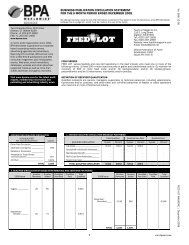February - Feedlot Magazine
February - Feedlot Magazine
February - Feedlot Magazine
- No tags were found...
Create successful ePaper yourself
Turn your PDF publications into a flip-book with our unique Google optimized e-Paper software.
WE ARESPECIALISTS IN:• DUST CONTROL• CATTLE COOLING• DE-WATERINGLet us show you how to turn yourrun-off water into a valuable resource.806-292-6900www.feedlotenvironmental.com“The farm bill may allocate up to50% cost sharing on our systems.2007 may be the last year to sign upfor your local eqip program. Call ustoday for more information.”Winter Herd Health ProblemsMay Be Curbed With GoodNutritionby Paul A. Davis, Ph. D.The cold, muddy, rainy conditions brought on by “OldMan Winter” often exacerbate the potential for healthproblems in cattle. Winter weather presents a two-foldproblem in regard to nutrition and animal health.Colder temperatures and concurring stage of productiondictate a higher plain of nutrition, while grassesand native forages are often dormant and of lownutritional value. While fall-calving cows are nursingolder, larger calves, spring-calving cows are either inheavy gestation or nursing newborn calves. In eithercase, nutritional demands are high and often the foragesand pastures offered cannot provide adequateamounts of protein and energy.To make matters worse, many of the bacteria, viruses,and parasites that plague cattle are inherent to theareas in which cattle are kept and most are opportunistic.Cattle that lose body condition due to malnourishmentand the stresses of calving, rebreeding,and/or weaning become more prone to contracting adisease or parasite infestation. Therefore, the first lineof defense in cattle health may well be nutrition. However,providing adequate nutrition during the wintermonths is not without its challenges.Cold temperatures in and of themselves are a stressorto livestock. During cold weather when it is neededmost, feed intake may be suppressed. Additionally,muddy conditions may cause a depression in intake offive to 25 percent and rain can cause temporary intakereductions of similar magnitude. To overcome the obstaclesof less nutrient density in forages and keep cattlein proper body condition and ward off disease,supplying additional nutrition is essential. Whenstressed cattle are presented with a disease challenge,the subsequent immune response is a protein and energyexpense. In other words, a protein and energy deficiencycan increase the chances of an animalsuccumbing to disease or infection! Furthermore, vaccinesare more efficacious when administered to an animalthat is adequate in status of protein, energy,vitamins, and minerals.Additional health problems may arise during timesof limited forage availability. As cattle are forced tosearch for alternate food sources, weeds, acorns, andmoldy or rotting hay may be utilized. Acorn poisoningis often observed when forage is short and cattle arehoused in pastures with abundant Oak trees. Cattle aredrawn to acorns by taste and tend to overeat greenacorns and become ill due to gallotannin. While providingplenty of hay so that cattle are not hungry or notallowing access to acorns at all are the best preventions,there is no specific antidote for the toxin.Circle No. 131 on Reply30 FEED•LOT <strong>February</strong> 2007



